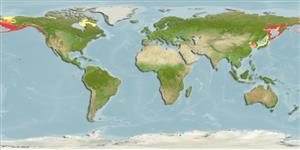Actinopterygii (ray-finned fishes) >
Pleuronectiformes (Flatfishes) >
Pleuronectidae (Righteye flounders) > Pleuronectinae
Etymology: Platichthys: Greek, platys = flat + Greek, ichthys = fish (Ref. 45335).
Environment / Climate / Range
Ecology
Marine; freshwater; brackish; demersal; catadromous (Ref. 51243); depth range 0 - 375 m (Ref. 6793). Polar, preferred 4°C (Ref. 107945); 70°N - 34°N
North Pacific: Korea and southern Japan through the Bering Strait and Arctic Alaska (Ref. 2850) to the Coronation Gulf, Northwest Territories, Canada and Santa Barbara, southern California, USA. Hybridizes with Parophrys vetulus - the hybrid, called Inopsetta ischyra, may be found from the Bering Sea to San Francisco, California, USA. Also hybridizes with Kareius bicoloratus (Ref. 27547).
Length at first maturity / Size / Weight / Age
Maturity: Lm ?, range 35 - ? cm
Max length : 91.0 cm TL male/unsexed; (Ref. 2850); common length : 57.5 cm TL male/unsexed; (Ref. 12193); max. published weight: 9.1 kg (Ref. 2850); max. reported age: 24 years (Ref. 28499)
Dorsal
spines
(total): 0;
Dorsal
soft rays
(total): 52-66;
Anal
spines: 1;
Anal
soft rays: 38 - 47;
Vertebrae: 34 - 37. Distinguished by the presence of both eyes on the same side of the head, dorsal and anal fins that are marked with dark and light (white to orange) bars, and especially, by the stellate, bony tubercles scattered over its body (Ref. 27547). Dorsal originates over middle of upper eye; anal with a sharp, forward pointing spine (often buried in skin) before first ray; pectorals are bluntly pointed; caudal slightly rounded (Ref. 27547). Eyed side dark brown to nearly black, sometimes with indefinite blotchings (Alaskans specimens sometimes with a greenish tinge); blind side white to creamy; dorsal fin with 4 to 7 dark bars with white to orange spaces between; anal fin with 4 to 6 such bars; caudal fin with 3 or 4 dark longitudinal bars on its posterior part; in rare cases, the blind side may be partly or completely colored like the eyed side, or white may be present on the eyed side, creating a piebald effect (Ref. 27547, 28897, 28898).
Found inshore, often in very shallow water and in estuaries during the summer; moving into deeper water in the winter (Ref. 27547). However, they may occur in deep water throughout the year (Ref. 27547). Does not venture into water of high salinities (Ref. 28899). Young and adults move up rivers, as much as 120 km (Ref. 27547). Benthic (Ref. 58426). Feeds on crustaceans, worms, small mollusks, brittle stars, and small fishes (Ref. 6885). Important game fish (Ref. 2850). Utilized fresh and frozen; eaten steamed, fried, boiled, microwaved, and baked (Ref. 9988).
Cooper, J.A. and F. Chapleau, 1998. Monophyly and intrarelationships of the family Pleuronectidae (Pleuronectiformes), with a revised classification. Fish. Bull. 96(4):686-726. (Ref. 30193)
IUCN Red List Status (Ref. 115185)
CITES (Ref. 94142)
Not Evaluated
Threat to humans
Harmless
Human uses
Fisheries: commercial; gamefish: yes
Tools
Special reports
Download XML
Internet sources
